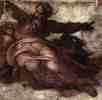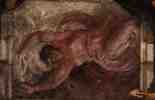 In full MICHELANGELO DI LODOVICO BUONARROTI SIMONI
(b. March 6, 1475, Caprese, Republic of Florence [Italy]--d. Feb. 18,
1564, Rome), Italian
Renaissance
sculptor, painter, architect, and
poet who exerted an unparalleled influence on the development of
Western art.
In full MICHELANGELO DI LODOVICO BUONARROTI SIMONI
(b. March 6, 1475, Caprese, Republic of Florence [Italy]--d. Feb. 18,
1564, Rome), Italian
Renaissance
sculptor, painter, architect, and
poet who exerted an unparalleled influence on the development of
Western art.
 David
David
Michelangelo Buonarotti (1475-1564) exerted enormous influence. He, too, was universally acknowledged as a supreme artist in his own lifetime, but again, his followers all too often present us with only the master's outward manner, his muscularity and gigantic grandeur; they miss the inspiration. Sebastiano del Piombo (c.1485-1547), for example, actually used a drawing (at least a sketch) made for him by Michelangelo for his masterwork, The Raising of Lazarus. Masterwork it is; yet how melodramatic it appears if compared with Michelangelo's own painting.
Michelangelo resisted the paintbrush, vowing with his characteristic vehemence that his sole tool was the chisel. As a well-born Florentine, a member of the minor aristocracy, he was temperamentally resistant to coercion at any time. Only the power of the pope, tyranical by position and by nature, forced him to the Sistine and the reluctant achievement of the world's greatest single fresco. His contemporaries spoke about his terribilitą, which means, of course, not so much being terrible as being awesome. There has never been a more literally awesome artist than Michelangelo: awesome in the scope of his imagination, awesome in his awareness of the significance--the spiritual significance--of beauty. Beauty was to him divine, one of the ways God communicated Himself to humanity.
Like Leonardo, Michelangelo too had a good Florentine teacher, the delightful Domenico Ghirlandaio (c.1448-94). Later, he was to claim that he never had a teacher, and figuratively, this is a meaningful enough statement. However, his handling of the claw chisel does reveal his debt to Ghirlandaio's early influence, and this is evident in the cross-hatching of Michelangelo's drawings--a technique he undoubtedly learned from his master. The gentle accomplishments of a work like The Birth of John the Baptist bear not the slightest resemblance to the huge intelligence of an early work of Michelangelo's like The Holy Family, also known as the Doni Tondo. This is somehow not an attractive picture with its chilly, remote beauty, but its stark power stays in the mind when more acessible paintings have been forgotten.
 The Holy Family with the infant St. John the Baptist (the Doni Tondo)
The Holy Family with the infant St. John the Baptist (the Doni Tondo)
All the same, it is the Sistine ceiling that displays Michelangelo at the full stretch of his majesty. Recent cleaning and restoration have exposed this astonishing work in the original vigour of its color. The sublime forms, surging with desperate energy, tremendous with vitality, have always been recognized as uniquely grand. Now these splendid shapes are seen to be intensely alive in their color, indeed shockingly so for those who liked them in their previous dim grandeur.
The story of the Creation that the ceiling spells out is far from simple, partly because Michelangelo was an exceedingly complicated man, partly because he dwells here on profundities of theology that most people need to have spelt out for them, and partly because he has balanced his biblical themes and events with giant ignudi, naked youths of superhuman grace. They express a truth with surpassing strength, yet we do not clearly see what this truth actually is. The meaning of the ignudi is a personal one: it cannot be verbalized or indeed theologized, but it is experienced with the utmost force.
 Creation of the Sun and Moon
Creation of the Sun and Moon
 The Separation of Light from the Darkness
The Separation of Light from the Darkness
There is the same power, though in more comprehensible form, in the great prophets and seers that sit in solemn niches below the naked athletes. Sibyls were the oracles of Greece and Rome. One of the most famous was the Sibyl of Cumae, who, in the Aeneid, gives guidance to Aeneas on his journey to the underworld. Michelangelo was a heavyweight intellectual and poet, a profoundly educated man and a man of utmost faith; his vision of God was of a deity all ``fire and ice'', terrible, august in His severe purity. The prophets and the seers who are called by divine vocation to look upon the hidden countenance of God have an appropriate largeness of spirit. They are all persons without chitchat in them.
 Delphes Sylphide
Delphes Sylphide
 Sybille de Cummes
Sybille de Cummes
The Erythraean Sibyl leans forward, lost in her book. The artist makes no attempt to show any of the sibyls in appropriate historical garb, or to recall the legends told of them by the classical authors. His interest lies in their symbolic value for humanity, proof that they have always been the spiritual enlightened ones, removed from the sad confusion of blind time.
The fact that the sibyls originated in a myth, and one dead to his heart (which longed for Christian orthodoxy) only heightens the drama. At some level we all resent the vulnerability of our condition, and if only in image, not reality, we take deep comfort in these godlike human figures. Some of the sibylline seers are shown as aged, bent, alarmed by their prophetic insight.
The implicit sense of God's majesty (rather than His fatherhood) is made explicit in the most alarming Last Judgement known to us. Is is Michelangelo's final condemnation of a world he saw as irredeemably corrupt, a verdict essentially heretical, though at that time is was thought profoundly orthodox. His judging Christ is a great, vengeful Apollo, and the power in this terrible painting comes from the artist's tragic despairs. He paints himself into the judgement, not as an integral person, but as a flayed skin, an empty envelope of dead surface, drained of his personhood by artistic pressure. The only consolation, when even the Virgin shrinks from this thunderous colossus, is that the skin belongs to St Bartholomew, and through this martyr's promise of salvation we understand that perhaps, though flayed alive, the artist is miraculously saved.
As grandly impassive as the Erythraean Sibyl is the heroic Adam in The Creation of Adam, lifting his languid hand to his Creator, indifferent to the coming agonies of being alive.
Thanks to the BMW Foundation, the WebMuseum mirrors, partners and contributors for their support.